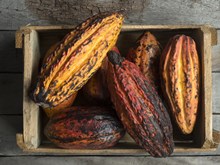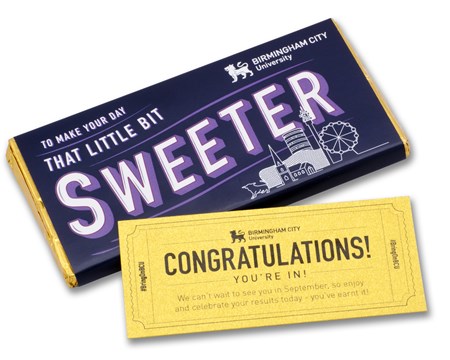What is chocolate made of?
High quality, gourmet, premium or fine dark chocolate, depending on your terminology, typically consists simply of cocoa (cocoa solids and cocoa butter), sugar (preferably cane sugar), natural vanilla (not Vanillin) and sometimes soya lecithin (a natural emulsifier).
It should contain no less than about 50% cocoa content, depending on the use, between 55% and 75% cocoa content is ideal. Higher cocoa contents up to 100% are available however for those who prefer a strong bitter chocolate and also a reduced or absent sugar content. Milk alone can be added to this fine dark chocolate to make milk chocolate, which typically contains 32% cocoa, although higher cocoa content milk chocolate is available and so providing a milk chocolate with increased richer flavours and reduced sugar.
White chocolate generally contains no cocoa solids at all, just the cocoa butter, and as such technically isn't chocolate. Most commercial, mass produced chocolate however is quite different, not only does it taste different - it is different. It can consist of dried milk, vegetable oil, unspecified and artificial flavours and a lot more refined sugars. The majority of cocoa beans used are also of a much lower grade, bulk cocoa beans as opposed to fine flavour cocoa beans, producing little flavour with a lesser cocoa content.
Chocolate history
The cocoa tree can be found roughly within the latitudes of 20 degrees north and 20 degrees south of the equator. It depends on the shade of other plants to survive throughout its growing stages, such as the banana, and only produces its first fruit around the tenth year of its life. Such fruits are the cocoa pods and it is these that contain the individual cocoa beans.
The first cocoa grew in South America and was used to create thick beverages combined with many other ingredients, including spices and herbs. This beverage style concoction was even used in sacred offerings, possibly by the Maya and then later by the Aztecs. Increasingly valued, cocoa beans were later used as currency. The Spanish invasion was the point when this treasured cocoa bean was discovered and eventually introduced to Spain and the rest of Europe. The cocoa bean that originally caused so much admiration was later named the Criollo (meaning native) and today this is still one of the world's most prized cocoa beans.
The cocoa bean
There are numerous cocoa varieties known and used today, the main types however are Criollo, Forastero and Trinitario. The resulting mixing of these main types results in cocoa such as Chuao and Java to name but a few, both these cocoa beans incidentally are named by their place of birth, as are many others. The country of origin and even the estate on which the cocoa is grown plays a large part in the end quality, flavour profile and labelling of such fine chocolate. This is mainly due to soil and weather conditions but the expertise and methods of the plantation workers and the chocolatier is obviously of huge importance to the end result.
The specific cocoa bean, or balance of blended cocoa beans, used in the making of high quality chocolate is an art in itself. Such cocoa beans have many individual qualities and distinctive flavours and by carefully blending these beans or using certain beans on their own, not forgetting the lengthy and various processing of the beans, determines the overall flavour. Too bitter or too acid and the balance is lost. It is worth mentioning here that there is no "better" chocolate between chocolate created from a blend of beans or chocolate created from a single variety or single origin of beans. The final quality results from the initial raw ingredients used and the many stages involved in making the chocolate, from the methods used to harvest the cocoa bean, the preparation of the beans and finally the experienced chocolatier that transforms the cocoa into the actual chocolate.
There are strong similarities in the creation of high quality chocolates, real chocolate, with the wine making process and coffee and tea. In fact the term "Grand Cru", so often used for fine wines, is also used to describe some fine chocolates created from a single/pure origin. Increasingly the world's most highly respected chocolatiers are promoting the actual cocoa beans used and just as importantly the origin of the cocoa bean, even the estate on which the cocoa beans are grown and harvested. As the general public increasingly realise the difference between candy style chocolate and real chocolate and this awareness filters through to the masses, the mass chocolate producers will begin to cash in on this. Quite simply, check the ingredients.
The main groups for labelling are; Single Origin Chocolate, made with cocoa beans from a particular country or area. Single Estate Chocolate, made with cocoa beans from a single estate or plantation, and in some cases; Single Variety Chocolate, made exclusively from one particular cocoa bean type. The most coveted cocoa beans are quite rare and therefore much more expensive, such as the Criollo, which accounts for approximately 3-5% of world chocolate production. The Criollo produces a chocolate with much fuller flavours and low acidity.
We have a wide selection of single origin/estate/variety chocolate created by the most prestigious chocolate makers such as Michel Cluizel, Amedei, Valrhona and Pralus. It is worth mentioning the high cocoa chocolates here as this is chocolate made with, in some cases, as much as 99% - 100% cocoa, very bitter to taste these high cocoa bars are the healthiest of chocolate with little or no sugar and also much higher in antioxidents.
How to taste chocolate?
If you want to explore the individual characteristics of the various cocoa beans used and their origins and perhaps find your ideal, then the best way to taste chocolate is to use other comparisons to help you differentiate between the various smells, flavours and textures. This is best performed comparatively with similar cocoa contents of unflavoured dark or milk chocolate bars from several manufacturers. This way you will not be distracted by the varying levels of sugar and milk content and your senses will be more focused.
Sight
First you will discover the differences in colour as different beans produce finished chocolate with varying colours from rich reds and coppers to dark browns. This is not a sign of quality and a common myth that the darker chocolate is somehow a better chocolate is certainly not the case.
Smell
Break a piece of chocolate and smell it. You need to understand what you are sensing, is it floral, fruity, earthy? Like wine tasting there are many associated smells and it is by recognising them that helps you decide whether it is to your liking, or not. Is the chocolate producing an intense aroma or is it subtle? Smells associated to a poor quality chocolate may be plastic or rubber, this can be due to poor fermentation or artificial drying of the cocoa beans. Another unfavourable sign is a heavy smokiness caused by drying the beans over wood fires (The ideal way to dry cocoa beans is simply under the sun, this is time consuming and therefore more expensive).
Taste
With a clean palette put a small amount of chocolate in your mouth and let it linger on your tongue for a short while and slowly move it around, extracting all the flavours. The main points to look out for in chocolate are firstly the hit of flavours and how long these last; ideally the flavours should steadily rise and linger rather than a "hit and run" effect. Also, the finest chocolate will produce a serious of flavours so creating a full and varied flavour profile from the first taste to the finish, rather than one level of flavour and that's it. Next are the basic flavours of acidity, bitterness, sweetness and astringency. Is the chocolate too sour or sweet, is the acidity just enough to assist any fruitiness or is it too overpowering. A well balanced sensation of flavours depicts a good chocolate, a monotonous and uninteresting taste and also an overpowering note depicts a poor chocolate.
Texture
Generally speaking, a silky smooth texture with an absence of any grittiness is the mark of a good chocolate. A gritty texture is due to poor conching of the chocolate (this is a process where the particles are repeatedly broken down). As this has nothing to do with the quality of the bean but the process itself it is placed as the final test of a good chocolate.
Storing Chocolate
Chocolate is ideally stored at 16-18 degrees and eaten at room temperature.
If you do need to put your chocolate in the fridge make sure it is sealed in a plastic container or bag to avoid moisture affecting the chocolate. Never eat chocolate taken straight from the fridge – the flavours will be completely lost.
The Science
Antioxidants in chocolate
We know you may find it difficult to achieve this state of mind, but fine chocolate really is good for you. Obviously eating too much of any one thing is not contributing to an overall balanced diet, but as we have all been told many times "a little of what you fancy does you good". And it’s true with high quality dark chocolate. Chocolate carries high levels of chemicals called phenolics, these are the same antioxidants as found in red wine (this news just gets better). Apparently, antioxidant phenolics prevent fat-like substances (cholesterol) in the bloodstream from oxidising and clogging the arteries which can, in turn, lead to heart disease. Research recently carried out at King’s College, London, suggests that these antioxidants found in cocoa can also help decrease stress levels and protect against disease.
In addition to its beneficial effect on blood cholesterol levels, recent research has shown that cocoa contains a wealth of phytochemicals and polyphenols, which have significant antioxidant properties and may help to reduce the risk of developing cancer. In fact, tests have shown that cocoa powder or high cocoa content chocolate bars have equivalent or greater antioxidant activities than many fruit and vegetables and even red wine. So it’s official, certain chocolate and red wine are not as bad as you might at first suspect and even provide health benefits.
A Chocolate high
Some scientists say chocolate contains substances that have the same effect on the brain as marijuana. A University of Michigan study says chocolate causes the brain to release b-endorphin, a naturally occurring chemical similar to opium. A similar study in Italy on chocolate identified the culprit to be a pleasure-inducing compound called anandamide to be responsible for imitating the effects of marijuana. However, you'd have to eat about 25 pounds of chocolate to get "high."
Caffeine in chocolate
The caffeine found in chocolate is negligible. Only 22mg found in a sample 50g bar of dark chocolate compared to 120mg found in a cup of coffee. Milk chocolate contains much less of course due to the lower cocoa content.
By The Chocolate Traveller
Chocolate Trading Company









